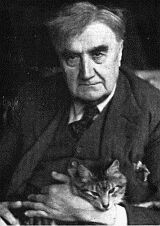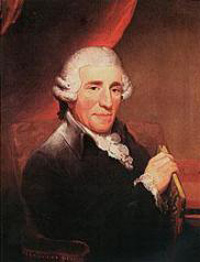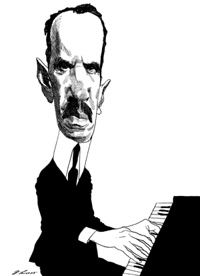| Love in Time of War | ||||||||||
Symphony No. 5 in D major In his long and productive life – his last symphony was premiered just four months before his death at age 85 – Ralph Vaughan Williams practiced what he preached. He wrote music for every kind of combination and level of sophistication in the belief, considered radical in his young days, that music was the birthright of every individual. Vaughan Williams's nine symphonies, spanning over 50 years, reflect the composer's changing outlook on life and the world around him. His early Sea Symphony reflects his liberalism and idealism through the poems of Walt Whitman. Later he expressed a more pastoral mood in the tone poem-like London and Pastoral symphonies. His unsettling and dissonant Fourth was his major experiment in musical modernism, quickly rejected. By the time of the D major symphony he reached a kind of tranquility and inner piece, in spite of the fact that its composition, begun in 1938, spanned the most horrific years of World War II. It received its premiere in June 1943. Vaughan Williams was an avid collector of the folk music of the British Isles, and there are few of his works that do not reference this tradition. While the Fifth Symphony quotes no specific folk melodies, its harmonic and melodic language is immediately recognizable as British. Nearly all the themes suggest folk origins. Note how many of the themes employ octaves and fifths, A British and Vaughan Williams melodic signature, similar to Aaron Copland’s “American” open harmonies. The Symphony opens Moderato, with a haunting horn call over the cellos and basses, answered by a short phrase on the violins.  The horn theme remains as a recurring rhythm throughout the movement. The violins introduce a second melody, reminiscent of, but much simpler than, the elegant opening of his The Lark Ascending. The horn theme remains as a recurring rhythm throughout the movement. The violins introduce a second melody, reminiscent of, but much simpler than, the elegant opening of his The Lark Ascending.  A third theme has an Irish cast. A third theme has an Irish cast.  An allegro middle section is stormy and agitated, An allegro middle section is stormy and agitated,  but it quickly returns to the haunting opening horn-call theme. but it quickly returns to the haunting opening horn-call theme.The Scherzo second movement, Presto, is hurried and unsettling, full of sudden short bursts of sound and rapidly shifting simple rhythms accentuated by the timpani.   The Trio features a sudden wild outburst from the brass and woodwinds. The Trio features a sudden wild outburst from the brass and woodwinds.  Suddenly the storm quiets down and the movement ends as in a whisper. Suddenly the storm quiets down and the movement ends as in a whisper.The themes of the tranquil Romanza originated in Vaughan Williams's draft for a never-completed opera on Bunyan's The Pilgrim's Progress. The music is serene and passionate, based on three themes: the first, a suitably melancholy English horn solo;  the second belongs to the strings; the second belongs to the strings;  the third, another birdsong-like melody, to the oboe. the third, another birdsong-like melody, to the oboe.  The theme is subsequently taken up by a solo horn. A violin solo brings the movement to a mysterious end. The theme is subsequently taken up by a solo horn. A violin solo brings the movement to a mysterious end.Since the late nineteenth century, the Baroque passacaglia (Chaconne) has commonly been repurposed to serve as a majestic symphonic conclusion. In the Finale, Passacaglia: Moderato the ground bass is introduced by the cellos,  but the actual theme, which is heard much more clearly follows as a melodic line. but the actual theme, which is heard much more clearly follows as a melodic line.  The passacaglia is repeated with variations ten times. The passacaglia is repeated with variations ten times.  In this Symphony, Vaughan Williams stays primarily in the tonic; when he changes key, it is an event. In this Symphony, Vaughan Williams stays primarily in the tonic; when he changes key, it is an event.  At the end of a folksy Scherzando middle section variation, the horn theme from the first movement returns and the Symphony ends in a noble hymn of praise. At the end of a folksy Scherzando middle section variation, the horn theme from the first movement returns and the Symphony ends in a noble hymn of praise.Vaughan Williams dedicated the symphony “to Sibelius, without permission.” since it was probably impossible in 1943 to contact the Finnish recluse behind the German lines. | ||||||||||
Cello Concerto in C major, Hob.VIIb:1 The authenticity of most of Franz Joseph Haydn’s cello concertos has been in question for the last two centuries. The existence of the Cello Concerto in C major, however, was always well-known, since it was listed by Franz Joseph Haydn in his Entwurf-Katalog (a draft thematic catalog) of his works, which the composer began compiling in 1765 after his patron, Nikolaus von Esterházy, admonished him for “negligence.” The date of composition, however, is up for grabs (probably between 1761 and 1768). For nearly 200 years it was considered lost, since neither the original manuscript nor a copy of a printed edition was ever found. But in 1961 a copy was discovered in a collection in the Czech National Library, confiscated from the Radenin Palace in Prague. It bore the signature of Joseph Weigl Sr., Haydn’s cellist, who was in the service of the Esterházy court from 1761 to 1768, and for whom Haydn probably composed it. Since there is no separate orchestral cello part in the score, it appears that the Esterházy orchestra had only a single cellist. Considering both the technical and musical demands of the work, Weigl must have been an outstanding musician. The first movement of the Concerto is dominated by a single theme, although the theme itself includes several motives that Haydn develops separately.  Haydn, who was always looking for ways to spice up conventional forms, begins rather sedately here until the cadenza, which includes unusual modulations and virtuosic tricks. Haydn, who was always looking for ways to spice up conventional forms, begins rather sedately here until the cadenza, which includes unusual modulations and virtuosic tricks.  The lyrical second movement contains a certain pathos we have come to associate more with Mozart than Haydn. It seems entirely likely that the richness of the voice of the solo instrument may have inspired in the composer a more intense emotional outpouring. The lyrical second movement contains a certain pathos we have come to associate more with Mozart than Haydn. It seems entirely likely that the richness of the voice of the solo instrument may have inspired in the composer a more intense emotional outpouring.  The spirited Finale, however, is the real showpiece for the soloist, especially in its rapid, staccato bowings. It represented another chance for Haydn to show what he could do in spinning out a single theme into a series of short motives and a large variety of rapidly changing moods.  The entire movement is also a real showpiece for the soloist, especially in its rapid, staccato bowings. The entire movement is also a real showpiece for the soloist, especially in its rapid, staccato bowings.  | ||||||||||
The Pleasure Dome of Kubla Khan American composer, pianist and teacher Charles Tomlinson Griffes was one of the most promising American composers of the early twentieth century. Unfortunately, like so many composers, he did not live to fulfill his promise, dying after only a dozen or so years of creativity. His musical studies in Germany instilled in him a thorough command of German late Romanticism, but after his return to the United States in 1907, he was influenced by the Impressionism of Debussy and oriental harmonies, introduced to him by a singer who returned from Japan with copies of Japanese melodies. To support his widowed mother and family, Griffes took a post as music instructor at the Hackley School in Tarrytown, NY. He hoped it would prove a temporary situation, but it lasted until his death, and he was unhappy in his life as a schoolmaster. Inspired by Samuel Taylor Coleridge's poem Kubla Khan, Griffes started The Pleasure Dome of Kubla Khan in 1912 as a piano work,and it was not until 1917 that the orchestral version of monumental forces–including two harps, piano, celesta and expanded woodwind and percussion sections was completed. Griffes offered the work to conductors Fritz Reiner and Leopold Stokowski, but neither showed much interest. It was finally performed by Pierre Monteux and the Boston Symphony in late 1919, a performance that established Griffes' reputation – success that he could only briefly enjoy, since he died four months later. It is unquestionably one of Griffes' most important compositions. In the program notes for the premiere with the Boston Symphony, Griffes wrote: “I have taken as the basis for my work those lines of Coleridge's poem describing the "stately pleasure-dome," the "sunny pleasure-dome with caves of ice," the "miracle of rare device." Therefore, I call the work "The Pleasure Dome of Kubla Khan" rather than "Kubla Khan." ... As to argument, I have given my imagination free rein in the description of this strange palace as well as of purely imaginative revelry which might have taken place there.” He added the following lines from the poem: In Xanadu did Kubla KhanGriffes’ music is an American version of the lush orientalism so popular in the West in the late nineteenth and early twentieth centuries, and first exemplified by Russian composers such as Rimsky Korsakov and Borodin, and later by the French, especially Debussy. Griffes also uses a variety of modes that suggest the vast stretch between Central Asia and China that was Kubla Khan’s empire – witness the sinuous oboe melody that constitutes the work’s principal theme.  Note the exotic percussion Griffes uses as a transition into a second poly-modal melody. Note the exotic percussion Griffes uses as a transition into a second poly-modal melody.  The collage of orchestral colors is designed to create a canvas of oriental grandeur and mystery. The collage of orchestral colors is designed to create a canvas of oriental grandeur and mystery. Whether Griffes was aware that Coleridge’s poem had sprung fully formed out of the poet’s opium stupor is not known; the music, however, embodies the same evanescence as smoke from an opium pipe. | ||||||||||
| Copyright © Elizabeth and Joseph Kahn 2017 | ||||||||||


